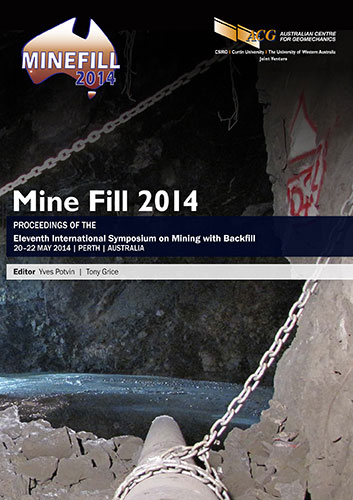Coupled thermo-hydro-mechanical-chemical processes in cemented paste backfill and implications for backfill design – experimental results

|
Authors: Fall, M; Ghirian, A |
DOI https://doi.org/10.36487/ACG_rep/1404_13_Fall
Cite As:
Fall, M & Ghirian, A 2014, 'Coupled thermo-hydro-mechanical-chemical processes in cemented paste backfill and implications for backfill design – experimental results', in Y Potvin & T Grice (eds), Mine Fill 2014: Proceedings of the Eleventh International Symposium on Mining with Backfill, Australian Centre for Geomechanics, Perth, pp. 183-196, https://doi.org/10.36487/ACG_rep/1404_13_Fall
Abstract:
In the field, a cemented paste backfill (CPB) structure is simultaneously subjected to mechanical (M), hydraulic (H), chemical (C), and thermal (T) loads from early to advanced ages once it has been built. Field studies have shown that the in situ properties and performance of CPB differ from those obtained in laboratory. This is mainly due to effects of the aforementioned coupled THMC processes. Thus, understanding and assessing the response of CPB to the aforementioned coupled THMC loads or processes are crucial to reliably determine the performance and optimal design of CPB structures. However, despite the tremendous progress that has been made in understanding the behaviour and assessment of the performance of CPB during the past few years, the THMC response of CPB is not yet fully understood, and to date, there is no study that addresses these issues. The deficiency of consideration given to these coupled THMC processes has long been defended on the basis that it is difficult to do so. However, it does not mean that these issues are not essential. A thorough understanding of the coupled THMC processes that occur in CPB are needed for economic reasons, mine-worker safety and the development of economically and environmentally sustainable mining strategies. This research program has been conducted during the past years in response to the limited knowledge about coupled THMC processes in CPB. The objectives of the present paper are firstly; to present and describe the developed THMC experimental setup that allows us to cure CPB under coupled THMC conditions, i.e. close to field conditions. The setup is capable to cure the CPB specimens under controlled curing under stress, curing temperature and various coupled THMC conditions, while continuously monitoring the evolution of total stress, pore pressure, suction, temperature, water drainage, chemical composition of the pore water and vertical deformation. Once the required curing time is achieved the specimen can be extracted and then subjected to various experimental mechanical, hydraulic and thermal tests; and secondly to present and discuss some samples of results with regards to the THMC response of CPB and their implications for the cost-effective design of backfill structures. The results of this paper will provide a better understanding of the field behaviour of CPB and thus contribute to the better design of CPB structures.
References:
Ahnberg, H 2007, ‘On yield stresses and the influence of curing stresses on stress paths and strength measured in triaxial testing of stabilized soils’, Canadian Geotechnical Journal, vol. 44, no. 1, pp. 54-66.
ASTM International 2006, ASTM C136: Standard Test Method for Sieve Analysis of Fine and Coarse Aggregates, ASTM International, West Conshohocken.
ASTM International 2007, ASTM D422-63: Standard Test Method for Particle-Size Analysis of Soils, ASTM International, West Conshohocken.
ASTM International 2010, ASTM D4318: Standard Test Methods for Liquid Limit, Plastic Limit, and Plasticity Index of Soils, ASTM International, West Conshohocken.
Barneyback, RS & Diamond, S 1981, ‘Expression and analysis of pore fluids from hardened cement pastes and mortars’, Cement and Concrete Research, vol. 11, no. 2, pp. 279-85.
Célestin, JC & Fall, M 2009, ‘Thermal conductivity of cemented paste backfill materials and factors affecting it’, International Journal of Mining, Reclamation and Environment, pp. 1-17.
Fall, M, Benzaazoua, M & Sae, E 2008, ‘Mix proportioning of underground cemented paste backfill’, International Journal of Tunnelling and Underground Space Technology, vol. 23, pp. 80-90.
Fall, M, Célestin, JC, Pokharel, M & Touré, M 2010, ‘A contribution to understanding the effects of temperature on the mechanical properties of cemented mine backfill’, Engineering Geology, vol. 14, no. 3-4, pp. 397-413.
Ghirian, A & Fall, M 2013, ‘Coupled thermo-hydro-mechanical-chemical behaviour of cemented paste backfill in column experiments, Part I: Physical, hydraulic and thermal processes and characteristics’, Engineering Geology, vol. 164, pp. 195−207.
Pokharel, M & Fall, M 2010, ‘Coupled thermo-chemical effects on the strength development on slag-paste backfill materials’, Journal of Materials in Civil Engineering, vol. 23, no. 5, pp. 511-25.
Taylor, HFW 1964, The chemistry of cements, 1st edn, Academic Press, London.
© Copyright 2025, Australian Centre for Geomechanics (ACG), The University of Western Australia. All rights reserved.
View copyright/legal information
Please direct any queries or error reports to repository-acg@uwa.edu.au
View copyright/legal information
Please direct any queries or error reports to repository-acg@uwa.edu.au